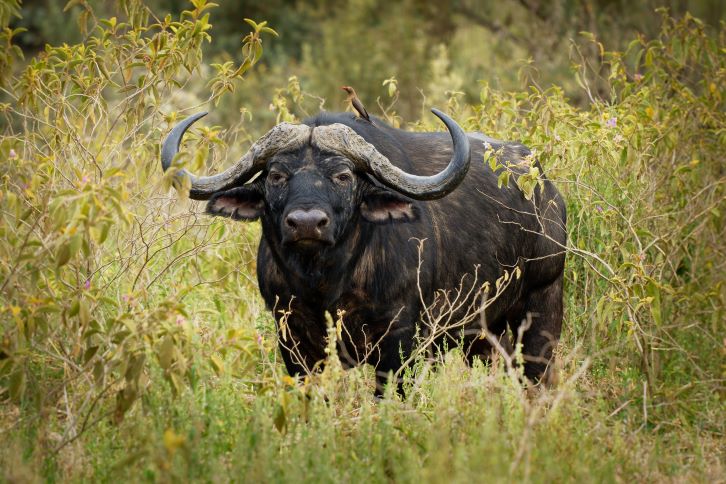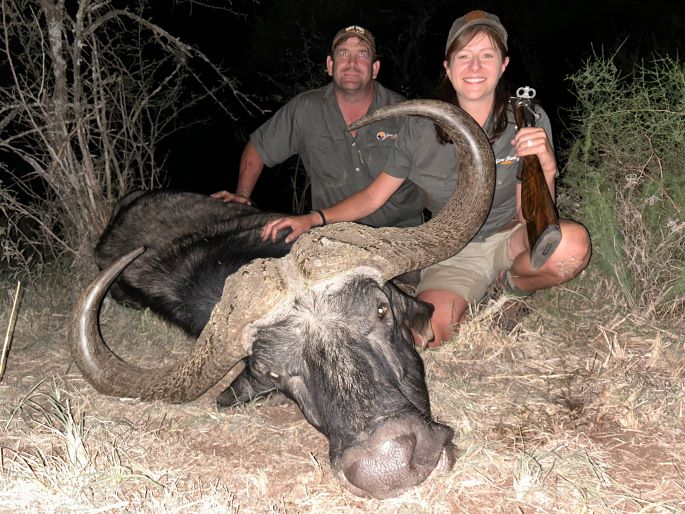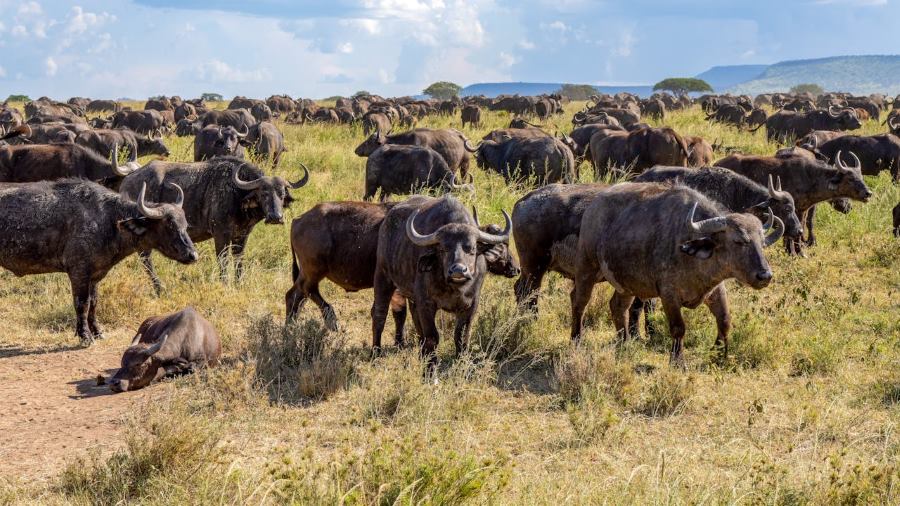An Africa hunting trip is a bucket list item for many, and for some, a regular game hunting experience. But for anyone lucky enough to successfully take down a member of the African big game family, the best part of the experience is the stories and memories that get told for all to hear.
And what better way to tell your story than with a physical reminder of those prized African buffalo hunts? Choosing to taxidermy any animal is a great way to preserve and ponder the successful experiences of these thrilling African hunting trips.
But what goes into the Cape buffalo taxidermy process? What does the trophy look like? How do you look after it? Some questions that I hope this blog will answer, or, at the very least, shed some light on.
[DYNAMIC-BLOGTABLEOFCONTENT]
Making the most of African Buffalo Hunts: Securing the Trophy
Cape buffalo hunts are some of, if not the most popular dangerous game hunting safari found on an African hunting trip menu. On a hunt, Cape buffalo can be challenging targets, their size belying a speed you wouldn’t want to run from. Another contributor is the fact that the Cape buffalo is the most affordable of the big game (and Big 5) offerings across the continent, giving hunters a decent trophy at a price that won’t require a second mortgage.
But first one needs to secure the trophy specimen. Buffalo are notoriously stubborn and often require a second (even third) shot before they successfully take to the ground. Cape buffalo hunts are not the time or place to practice a shot to the head or neck, these require expert accuracy and a high-powered rifle, so leave this one to the masters. The best option when felling these beasts of the bush is a shot to the organs; namely the heart or the lung, these organs are large and when struck correctly, the buffalo will stumble a few steps before dropping to the ground.

What makes a good Cape buffalo trophy?
While the lion has the mane, the buffalo has the boss. A Cape buffalo’s boss is its crowning glory, apart from the horns that is. A “good” trophy requires a hard boss, this hardening usually occurs from the age of 8. A hard boss usually refers to a boss with no hairline split in the middle.
A bull is considered to be of decent trophy quality when the horns have a measurement of 36 – 40 inches. The trophy score requires a measurement from tip to tip across the outside curve, and a measurement from tip to tip across the boss.
Cape buffalo hunts generally target the bulls, as they pack the muscle and signature trophy quality. However, many game hunting destinations allow hunters to take on the females of this species. While they can be a good hunt (and trophy), the bulls are still king.
There are “purists” who believe a trophy buffalo needs to be well mature and around or even over the age of 15 years, as it’s thought that age produces better quality horn specimens. However, much like in humans, it’s genetics and not age that determine the size and quality of these African big game trophies. Some buffalo never grow a closed boss, which does not (or should not) take away from the quality and delight of Cape buffalo hunts across the African continent.
Prep and Prime: Processes Involved in African Big Game Taxidermy
The Immediate Aftermath: Crucial Care while in the Game Hunting Environment
Animals are much like humans when it comes to death; when the blood flow stops, things can start to get less than perfect. As important as those photos are, take them as quickly as possible. The sooner your trophy can get to the coolness of the skinning shed the better; this will help slow down the immediate effects of death and plays an important role in trophy quality. Dirt, bush, and blood can create a breeding ground for bacteria that can enter through the shot site or skin; including the kind that can cause hair to fall out. For this reason, it is advised that hunters (more so the outfitter) carry a clean tarp or sheet to place the carcass onto for transport, especially while walking back to the vehicle.
Time is of the essence in any situation on an Africa hunting trip, but more so when it comes to transporting a large trophy through the bushveld, under a blazing sun, and then traveling back to the camp or prep shed.
When it comes to the large trophies of African buffalo hunts, skinning can sometimes take place out on the hunting ground to preserve and protect the integrity of the skin and hair. This cuts out on worrying about potential damage while waiting for the hunting vehicle or transport truck.

Disinfecting
Animal bones and body matter can harbor bacteria and potentially diseases that you wouldn’t want to bring back from African buffalo hunts. Correct cleaning and disinfecting of the horns and any bone matter used in the trophy mount will ensure the highest sanitization and can improve the look and longevity of the mount.
Horns and skull bones used in a mount will first be boiled to loosen and soften any remaining muscle, fat, or organic tissues so that they can be scraped off before moving on to the next stage. Once boiled, the bones and horns are soaked in a 0.1% bleach solution to further disinfect and whiten the exterior surfaces. Once completed, the horns and skull are soaked in a formaldehyde solution as a form of preservation and further decontamination. Lastly, soaking it in hydrogen peroxide is the last step in the cleaning process. It ensures that bones and horns are as white as possible and ready for the taxidermy process.
Presenting your Cape buffalo Hunting Trophy: Choosing a Mounting Style
There are various mount styles one can choose to display their Cape Buffalo hunts trophy. Each manner of mounting has its special appeal and character, and the hunter can base their choices on the type of look or presence they want to achieve.
Influencing factors in the style choice of African buffalo hunts trophies can vary from cost, personal appeal, and even how much space the hunter has to display their Africa hunting trip memorabilia. But rest assured, there is a mounting style for everyone’s taste.
European Mount
Commonly referred to as a skull mount, this style of trophy is the most economical and easiest to care for. Making use of the skull and horns mounted on a wooden board or backing, the European mount has an old-world, almost Viking appeal in its look.
Pedestal Mount
This option can be made using only the head or include the body up to the shoulder joint. Displayed on a wooden pedestal of the hunter’s choosing, this trophy-style turns a mount into a display one can appreciate from a full 360º walk around.
Using the head, shoulder, and chest; this mount makes full use of the available hide to create an entirely individual piece of work that can be enjoyed from almost any angle regardless of where it stands.
Pedestal Wall Mount
This best of both worlds is between a pedestal mount and a wall mount. This trophy also includes the head, neck, and shoulder; but where a traditional wall mount has a flat backing, this one hangs on a curved board, giving a more 3–D effect. This can be a good choice for those wanting the lifelike look of a pedestal while saving on space and costs.
Shoulder Mount
The traditional choice of trophy hunting since the early days, the shoulder mount might not be the most exciting trophy, but it stands as a popular choice nonetheless. Using the head, face, neck, and chest up to the shoulder joint; the shoulder mount allows for a highly realistic look focusing on the buffalo’s face and horns.
Unlike the pedestal wall mount which has a curved backing, the traditional shoulder mount has a flat back and hangs flush with the wall.
From your Africa Hunting Trip to your Home: Trophies and Travel
Trophies from Cape buffalo hunts can be transported one of two ways. Factors that can influence the method chosen include cost, travel schedules, and how soon the hunter wants their quarry back home. Another factor is whether or not the hunter chooses to have their trophy mounted locally after their dangerous game hunting safari, or at home where they might have a preferred service provider.
The below summarizes the two options available. Consider the above-mentioned when making your decision or discuss with your PH and outfitter about the best option for you and your unique preferences.
Dip and Pack: Preparing the African buffalo hunts materials for Taxidermy at the Hunter’s Convenience
This method is employed when the hunter chooses to have their trophy mounted on home soil. When the animal arrives back at the ranch, it gets taken to the skinning shed, where it gets skinned and salted, this then gets collected by a taxidermist for the next stages of preparation.
The taxidermist will boil and disinfect any bone material used in the trophy like the skull and horns, while the hide gets chemically treated and dried.
Once fully dry, all elements of the trophy are carefully packed and crated for transport. From here they will be collected and make their way to Customs and eventually find themselves on the way to the hunter for further processing.
Mount and Pack: Shipping a ready-to-hang African Big Game Trophy
The mount and pack method involves the mount being done entirely in the local area in which the hunt takes place, with the finished trophy being exported to the hunter.
This process starts the same as above with skinning and salting. However, the hide will then be fully tanned to meet the mounting requirements. The skin is placed on a model or mannequin figure to be shaped and stitched into form before being left to dry completely, a vital step in the taxidermy order. Once the skin is ready, details like the nose, eyes, and mouth are attended to, and finer detailing is carried out as needed.
When completed, the mount is packed and crated for shipping, kicking off the logistics leg of the trip.
For more information on the parties and permits involved in shipping an African buffalo hunts trophy, check out our blog on Big Game Hunting: Let’s Talk Taxidermy and Trophies.

Keeping your Game Hunting Trophy in Top Nick: Taxidermy Care and Maintenance
As with anything in life, the better care you take of it, the longer you’ll be able to enjoy it, and game hunting trophies are no different. Trophies of your African buffalo hunts can be preserved for years to come with the proper care and cleaning.
The Sun is the Enemy: Light and Heat
We all know what the sun and its UV rays are capable of doing to the human skin, and trophy mounts are no different. The heat of the sun can cause the hide to further dry out and even shrink, making your prize mount look older and shabby. And despite those grand scenes of a mount above a fireplace, that heat can be just as damaging, if not more so, and will cause damage to both the hide and hair.
Just because Cape buffalo hunts take place in blazing sun and high-heat environments, doesn’t mean that their trophies can be handled in the same way.
Moisture and Mayhem
On the other end of the stick, while you might want your mount to hang in your basement man–cave, any moisture in the environment will find its way into your trophy. While the hide and other materials of the mount have been treated they are still of natural origin, and when in contact with moisture mold and even fungus can find their way into the hair and backing of a trophy.
Dust
Dust is the bane of most household décor, and your African big game trophy will be one of the biggest dust collectors of all. Dust can accumulate in the hair, making it look dirty and “matted,” while dust on the eyes, nose, and horns can cause the finish to look dull and lifeless.
Mounted trophies can be dusted with a vacuum brush attachment or with a soft dry cloth, like microfiber. For dust (and smoke residue) that’s made its way deeper into the hair and other crevices around the ears and eyes, it’s recommended to use a can of compressed air FOLLOWING THE DIRECTION OF THE HAIR. This instruction is very important as going against the natural hair direction can cause it to break and even fall out. A gentler approach is to use a clean makeup brush to brush away dust and grime from smaller areas or to further detail the trophy.
It’s in the eyes
The eyes are no doubt one of the most important details on a trophy mount and over time these too can become dull due to dust, smoke, and other particles that cling to the dirt. A widely common suggestion is to use an earbud (Q–tip or small makeup swab) lightly dipped or sprayed with any glass cleaner. The keyword is lightly, any excess product that drips down onto the hide and hair can damage the finish and look of the mount. Once cleaned, they can be buffed with a soft dry cloth.
Keeping the boss in check
Let’s face it, the main aspect of those Cape buffalo hunts trophies are the horns, and that signature boss. The surface of this area is slightly rough and can collect (and keep) dust like no other part of the trophy. The best way to keep this area dust-free is to start with a vacuum and brush attachment, followed by a thorough yet gentle brushing with a general-purpose cleaning brush with plastic or nylon bristles to get into the jagged and uneven spaces where dust and dirt can cling.
Once the horns have been dusted in depth, one can go over them with a lightly damp cloth to finish it off. UNDER NO CIRCUMSTANCES SHOULD OIL BE APPLIED TO THE HORNS, putting oil on the horns of a trophy buffalo can cause them to discolor or even blacken, this oil can also run down into the hair and hide causing further unnecessary issues.
Some taxidermy providers can supply specific cleaners made to enhance and care for the materials of the trophy, speak to your service provider about the availability and usefulness of these products to further benefit the cleaning and care of your trophy.
Should your trophy at any point become heavily soiled or damaged, you should see a professional rather than trying to wash or repair it yourself. Washing of trophy mounts is a fine art, not very different from the start of the taxidermy process. Most minor incidences and daily dirt can be handled in-house, but when it comes to bigger jobs, call someone with the knowledge and experience necessary to keep your trophy in top form.

Why Taxidermy?
Taxidermy is an art, one that takes the result of a hunter’s hard work and efforts and turns it into a lifelong reminder and souvenir. African buffalo hunts test a hunter’s mettle and skill, so having a physical reminder of their achievement, makes the hours of walking and tracking through blazing sun and harsh environments all the more worthwhile.
Africa is home to many game hunting taxidermists whose preparation products and final productions can perform on a world-class level; and by supporting the local business environment, you can keep the industry going and growing for the future.
Author: A. Baker
